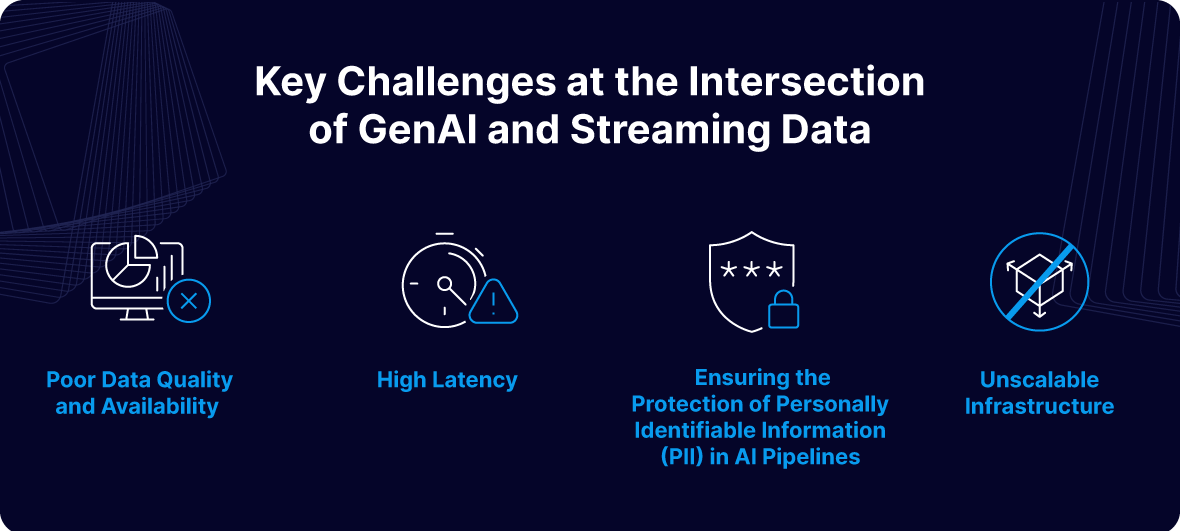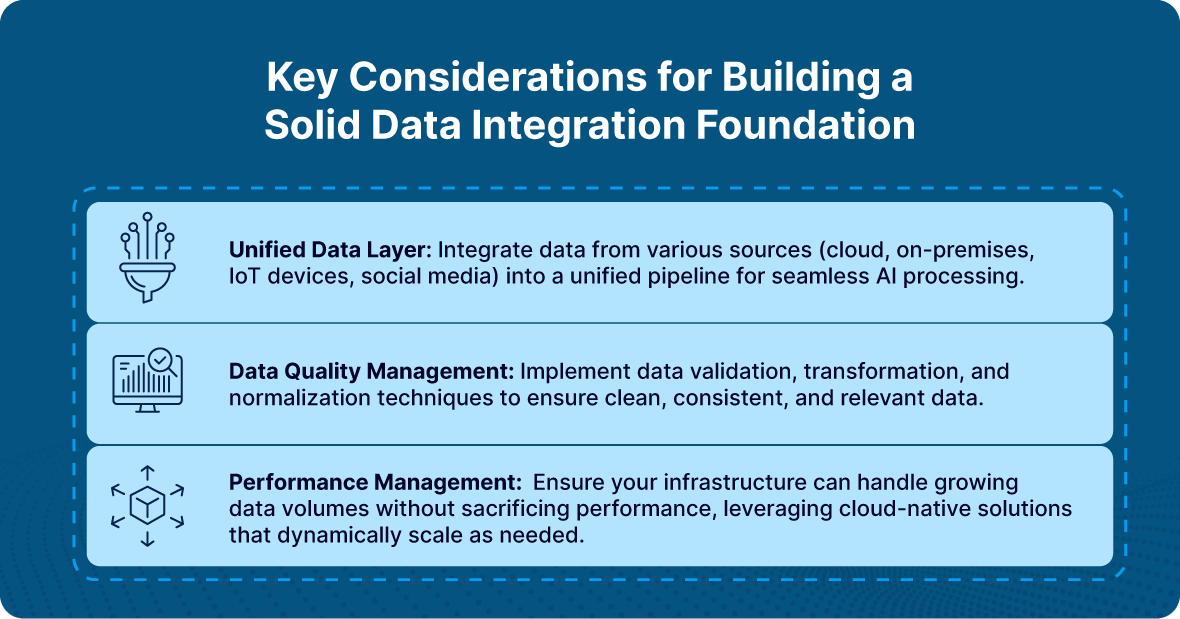In today’s competitive environment, enterprises need to harness data the instant it’s created. But data teams often face challenges when it comes to capturing, processing, and integrating high-velocity data streams from diverse sources—making it difficult to keep AI applications timely and relevant. Simultaneously, generative AI (GenAI) is becoming indispensable for delivering dynamic, real-time solutions, from chatbots and personalized marketing to adaptive decision-making.
Where these two trends collide—real-time data streaming and GenAI—lies a major opportunity to reshape how businesses operate. However, turning this vision into reality requires more than just powerful AI algorithms. Today’s enterprises are tasked with implementing a robust, flexible data integration layer capable of feeding GenAI models fresh context from multiple systems at scale.
In this post, we’ll explore the synergy between GenAI and streaming data and how this powerful combination is set to shape the next era of enterprise AI.
Key Challenges at the Intersection of GenAI and Streaming Data
While the merging of real-time data with GenAI offers exciting possibilities, the path forward is certainly not without challenges, such as:
1. Poor Data Quality and Availability
AI’s success is highly dependent upon data quality. To achieve accurate and reliable results, businesses need to ensure their data is clean, consistent, and relevant. This proves especially difficult when dealing with large volumes of high-velocity data from various sources.
To address this, enterprises need robust data validation systems that clean, filter, and process data streams in real time. Consistent monitoring and real-time integration are also necessary to ensure that data remains reliable and relevant for AI models.
2. High Latency
Real-time applications such as fraud detection, personalized marketing, or anomaly detection require low-latency. If the data infrastructure can’t process and deliver insights in near real-time, the value of streaming data and GenAI models diminishes rapidly.
For businesses using GenAI for customer support, for example, a chatbot must provide responses almost instantaneously, reflecting the latest user inputs. Without low-latency systems, customers may experience delays, leading to reduced satisfaction and engagement.
3. Ensuring the Protection of Personally Identifiable Information (PII) in AI Pipelines
When processing high-velocity streams of data, particularly in GenAI models, protecting sensitive information is crucial. As AI systems increasingly handle vast amounts of personal and confidential data, ensuring that PII remains secure becomes a major challenge. Without robust safeguards in place, there is a risk of unauthorized access or accidental exposure, which could compromise privacy and violate regulatory requirements, eroding customer confidence.
4. Unscalable Infrastructure
As data volume, variety, and velocity increase, organizations must invest in scalable infrastructure that can handle vast and growing datasets. With the rise of IoT devices and increased automation, businesses will generate even larger amounts of data, meaning infrastructure must be able to scale both horizontally and vertically.
The Future of Enterprise AI: Moving from Vision to Reality
Successfully integrating GenAI with real-time data streaming requires strategic investments across infrastructure, data governance, and AI model development. Here are the critical steps enterprises should take to turn this vision into a tangible, scalable solution.
1. Establish a Solid Data Integration Foundation
To power real-time GenAI models, businesses need a robust data integration infrastructure capable of handling high-velocity streams from multiple sources. It’s also imperative that real-time data streaming platforms are scalable to ensure that data can be ingested, processed, and delivered to AI models in real time.
Key considerations for building this foundation include:
- Unified Data Layer: Integrate data from various sources (cloud, on-premises, IoT devices, social media) into a unified pipeline for seamless AI processing.
- Data Quality Management: Implement data validation, transformation, and normalization techniques to ensure clean, consistent, and relevant data.
- Performance Management: Ensure your infrastructure can handle growing data volumes without sacrificing performance, leveraging cloud-native solutions that dynamically scale as needed.
Example Use Case: Financial institutions can integrate live transaction data, currency exchange rates, and customer behavior patterns into GenAI models for real-time personalized banking services.
2. Prioritize Real-Time Data Governance and Privacy
Real-time data streaming brings significant privacy and governance challenges. Organizations must implement privacy-preserving practices such as encryption, anonymization, and tokenization to protect sensitive data.
Steps for ensuring governance include:
- Real-Time Data Monitoring: Continuously track data integrity and security as it flows through your pipeline to ensure accuracy and protect PII.
- Compliance with Regulations: Ensure that AI models comply with global data privacy regulations, such as GDPR and CCPA, and integrate compliance checks into the data pipeline.
Striim offers AI agents Sentinel and Sherlock, which leverage advanced AI to detect and protect sensitive data in real time. Sherlock monitors your data streams to identify sensitive information. Sentinel applies protection methods including masking or encryption to safeguard your data.
Example Use Case: A healthcare provider can integrate patient data into real-time AI-driven applications while ensuring compliance with healthcare privacy laws with the help of PII masking.
3. Leverage Continuous Model Training and Fine-Tuning
For GenAI models to stay relevant, they must be continually updated with new data. Real-time data streaming allows for the continuous retraining of AI models, ensuring that they adapt to emerging trends, changes in user behavior, and evolving business needs.
Key steps include:
- Real-Time Model Retraining: Set up processes for automatic model updates as new data arrives, ensuring the AI remains accurate and responsive.
- Feedback Loops: Incorporate real-time feedback from AI models to refine and improve data quality and decision-making.
Example Use Case: E-commerce platforms using real-time browsing data can continuously update product recommendation models, keeping content aligned with current trends.
4. Invest in Scalable Infrastructure
To manage the growing volume of real-time data and the increasing demands of GenAI, businesses need flexible, scalable infrastructure. Cloud-native solutions, edge computing, and distributed frameworks enable companies to process vast amounts of data quickly and efficiently.
Striim Cloud is designed to support these needs by offering fully managed, real-time data streaming pipelines, allowing organizations to build and scale data processing workflows in minutes. With Striim Cloud available on AWS, Google Cloud, and Microsoft Azure, businesses can ensure seamless data integration, rapid decision-making, and low-latency performance across both cloud-native and edge computing environments.
Example Use Case: A logistics company can use Striim’s cloud native infrastructure to stream data from IoT sensors in real time, optimizing fleet operations and reducing maintenance costs.
5. Foster Cross-Functional Collaboration
Realizing the potential of GenAI and streaming data requires collaboration between data teams and business stakeholders. Alignment across departments ensures that AI models meet business goals and deliver measurable value.
Key strategies for fostering collaboration include:
- Unified Business Goals: Ensure that all stakeholders understand the value of real-time data and GenAI models for achieving business outcomes.
- Agile Development: Adopt agile practices to enable rapid prototyping and iteration, allowing teams to test and refine AI solutions quickly.
Example Use Case: Retailers seeking to implement dynamic pricing models based on real-time customer data will benefit from close collaboration between data scientists and business analysts to ensure pricing strategies align with market conditions.
The Future of Enterprise AI
The combination of GenAI and real-time streaming data represents a massive opportunity for businesses to drive innovation, optimize operations, and provide more personalized experiences. However, to fully capitalize on this potential, enterprises must invest in scalable, secure, and efficient infrastructures, maintain continuous learning systems, and foster cross-functional collaboration. Ready to see how Striim can accelerate your data and AI initiatives? Schedule a demo today to explore powerful real-time streaming and data integration solutions tailored to your organization’s needs.























